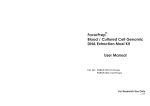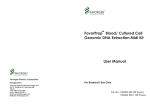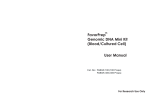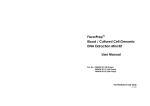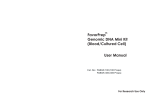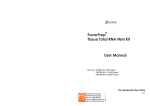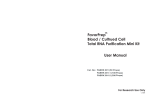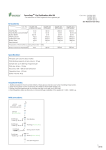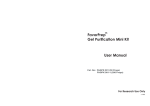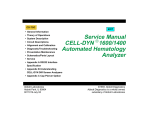Download User Manual FavorPrep Blood / Cultured Cell Genomic DNA
Transcript
TM FavorPrep Blood / Cultured Cell Genomic DNA Extraction Maxi Kit User Manual Cat. No.: FABGK 003 (10 Preps) FABGK 003-1 (24 Preps) For Research Use Only v.1108 Troubleshooting: Introduction TM FavorPrep Genomic DNA Extraction Maxi Kit is an excellent tool offering a speedy and economic method to purify total DNA (e.g. genomic, mitochondrial and viral DNA) from whole blood (fresh or frozen), plasma, serum, buffy coat, body fluids, lymphocytes and cultured cells. This technology first lyses cells and degrades protein by using a chaotropic salt and Proteinase K, then binds DNA to silica-based membranes, washes DNA with ethanol-contained Wash Buffer and then elutes purified DNA by low salt Elution Buffer or ddH2O. Compare with other harmful and timeconsuming procedures, such as phenol/chloroform extraction and ethanol TM precipitation, FavorPrep shortens the handling time about 1 hour. The size of purified DNA is up to 50 Kb (predominantly 20-30 Kb). After using TM FavorPrep Genomic DNA Extraction Maxi Kit, the high quality total DNA can be used directly for the downstream applications. • Too many cells were used --- reduce the sample volume. • Poor cell lysis because of insufficient Proteinase K activity --- Use a fresh or well-stored Proteinase K stock solution. • Poor cell lysis because of insufficient mixing with FABG buffer --- Mix the sample and FABG Buffer immediately and thoroughly by pulse -vortexing. • Poor cell lysis because of insufficient incubation time --- Extend the incubation time and make sure that no residual particulates remain. • Ethanol is not added into the lysate before transferring into FABG Maxi Column • Ethanol is not added into Wash Buffer when first open; the volume or the percentage of ethanol is not correct before adding into Wash Buffer Kit Contents FABGK 003 (10 Preps) Cat. No. / preps Proteinase K powder+ 55 mg FABG Buffer FABGK 003-1 (24 Preps) 130 mg 110 ml 270 ml 33 ml 88 ml Wash Buffer** (concentrated) 20 ml 40 ml Elution Buffer 30 ml 60 ml FABG Maxi Column 10 pcs 24 pcs Elution Tube (50 ml tube) 10 pcs 24 pcs W1 Buffer* Low yield (concentrated) User Manual 1 1 + Add 5.5 ml / 13 ml of sterile ddH2O to Proteinase K tube to make a 10 mg/ml stock solution when first open. * Add 12 ml / 32 ml of ethanol (96~100%) to W1 Buffer when first open. ** Add 80 ml / 160 ml of ethanol (96~100%) to Wash Buffer when first open. 1 • Elution of genomic DNA is not efficient --- Make sure the pH of ddH2O is between 7.5- 8.5. --- After Elution Buffer or ddH2O is added, stand the FABG Maxi Column for 5-10 min before centrifugation. Column is clogged •Blood sample contains clots --- Mix the blood sample well with anti-coagulant to prevent formation of blood clots. •Sample is too viscous --- Reduce the sample volume. Purified DNA dose not perform well in downstream application •Sample is old --- Always use fresh or well-stored sample for genomic DNA extraction. •Residual ethanol contamination --- After Wash step, centrifuge at 4,000 x g for an additional 10 minutes to dry the FABG Maxi Column. •RNA contamination 6 11. Place the FABG Maxi Column into a new 50 ml centrifuge tube. (Elution Tube) (provided) Specification 12. Add 1 ml of preheat Elution Buffer or ddH2O (pH 7.5- 9.0) to the membrane center of the FABG Maxi Column. Stand the FABG Maxi Column for 5 min at room temperature. ---Important Step! For effective elution, stand the FABG Maxi Column for 5 minutes is required to make sure that Elution Buffer is absorbed completely by column membrane. ---Standard volume for elution is 1 ml. If higher DNA yield is required, repeat the DNA Elution step (step 12) to increase DNA recovery. Sample Size : up to 10 ml of fresh/ frozen blood 8 up to 1 x 10 of cultured cells 13. Centrifuge at 4,000 x g for 2 minutes to elute total DNA. Handling Time: about 1 hour Column Capacity: up to 500 µg of Genomic DNA Average DNA yield : 35 µg/ 1 ml whole blood Format: spin column Elution Volume: 1-2 ml Protocol: (for Cultured Cell DNA Extraction) Please Read Important Notes Before Starting The Following Steps. 8 1. Transfer up to 1 x 10 of cells to a 50 ml centrifuge tube (not provided). Centrifuge at 4,000 x g for 5 minutes to pellet the cells. ---If using adherent cells, trypsinize the cells before harvesting. 2. Resuspend the cells with 10 ml of PBS. 3. Add 500 µl of Proteinase K (10 mg/ml) to the sample, mix well by vortexing. 4. Add 10 ml of FABG Buffer to the sample mixture. Mix thoroughly by pulse-vortexing. ---Do not add Proteinase K directly to FABG Buffer. 5. Incubate the sample mixture at 60 ºC for 20 minutes to Iyse the sample. During incubation, invert the tube every 3-5 minutes. ---At this time, preheat required Elution Buffer or ddH2O (1ml per sample) to 70 ºC. (For DNA Elution) 6. Follow the Blood protocol starting from step 4. 5 Important Notes 1. Buffers provided in this system contain irritants. Wear gloves and lab coat when handling these buffers. 2. For Cat. No. FABGK 003, add 5.5 ml of sterile ddH2O to Proteinase K tube; For Cat. No. FABGK 003-1, add 13 ml of sterile ddH2O to proteniase K tube to make a 10 mg/ ml stock solution. Vortex and make sure that Proteinase K powder has been completely dissolved. Store the stock solution at 4 °C. 3. For Cat. No. FABGK 003, add 12 ml of ethanol (96~100 %) to W1 Buffer when first open. For Cat. No. FABGK 003-1, add 32 ml of ethanol (96~100%) to W1 Buffer when first open. 4. For Cat. No. FABGK 003, add 80 ml of ethanol (96~100%) to Wash Buffer when first open. For Cat. No. FABGK003-1, add 160 ml of ethanol (96~100%) to wash Buffer when first open. 5. Preheat a dry bath or water bath to 70 °C before the operation. 6. Use a centrifuge with a swinging bucket rotor for 15ml (Midi) or 50ml (Maxi) in all centrifugation steps. The maximum speed should be 3500-5000 rpm or 3000-5000 x g. 2 Brief Procedure Lysis (FABG Buffer) (Proteinase K) 60°C, 20minutes centrifuge centrifuge DNA Binding Washing (W1 Buffer) (Wash Buffer) DNA Elution (Elution Buffer) Pure DNA General Protocol: (for Blood DNA Extraction) Please Read Important Notes Before Starting The Following Steps. 1. Transfer up to 10 ml sample (whole blood, buffy coat) to a 50 ml centrifuge tube (not provided). 8 9 ---For lymphocytes sample, transfer 10 ~10 cells to a 50 ml centrifuge tube and make total volume to 5 ml with PBS. 2. Add 500 µl of Proteinase K (10 mg/ml) to the sample, mix well by vortexing. And then add 10 ml of FABG Buffer to the sample mixture. Mix thoroughly by pulse-vortexing. ---Do not add Proteinase K directly to FABG Buffer. 3 3. Incubate the sample mixture in a 60 ºC for 20 min to Iyse the sample. During incubation, invert the tube every 3-5 minutes. ---At this time, preheat required Elution Buffer or ddH2O (1~2 ml per sample) to 60 ºC. (For DNA Elution step) 4. (Optional): If RNA-free genomic DNA is required, add 10 µl of 100 mg/ml RNase A (not provided) to the sample mixture and incubate at room temperature for 10 minutes. 5. Add 10 ml of Ethanol to the sample mixture. Mix thoroughly by vortexing. If precipitate appears, break it by pipetting. 6. Place a FABG Maxi Column to a 50 ml centrifuge tube (not provided). And transfer 15 ml of sample mixture (ethanol added) (including any precipitate) carefully to the FABG Maxi Column. Close the cap and centrifuge at 4,000 x g for 5 min. 7. Discard the flow-through and transfer the rest sample mixture to the same FABG Maxi Column. Close the cap and centrifuge at 4,000 x g for 5 min and discard the flow-through. 8 Add 4 ml of W1 Buffer (ethanol added) to the FABG Maxi Column. Close the cap and centrifuge at 4,000 x g for 5 min. Discard the flowthrough and place the FABG Maxi Column back in the 50 ml centrifuge tube. ---Make sure that ethanol has been added into W1 Buffer when first open. 9. Add 7 ml of Wash Buffer (ethanol added) to the FABG Maxi Column. Close the cap and centrifuge at 4,000 x g for 5 min. Discard the flowthrough and place the FABG Maxi Column back in the 50 ml centrifuge tube. ---Make sure that ethanol has been added into Wash Buffer when first open. 10. Centrifuge at 4,000 x g for an additional 10 min to dry the column. ---It might be necessary to dry the column further by placing the column in a vacuum oven at 70 °C for 10 minutes. ---Important Step! The residual liquid can affect the quality of DNA and inhibit subsequent enzymatic reactions. 4






